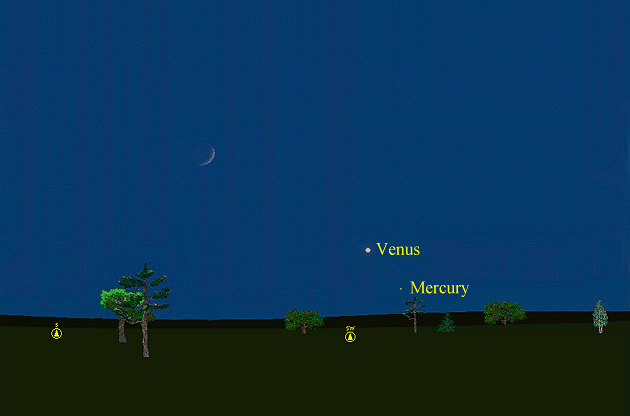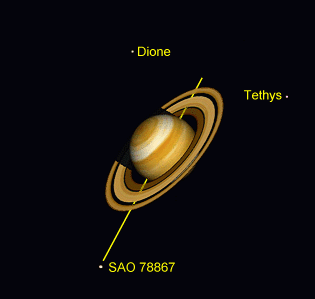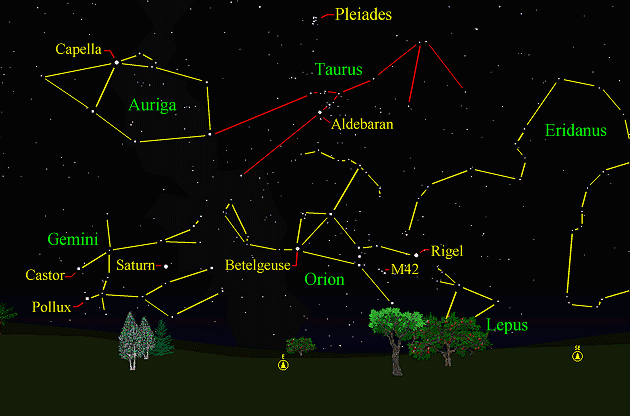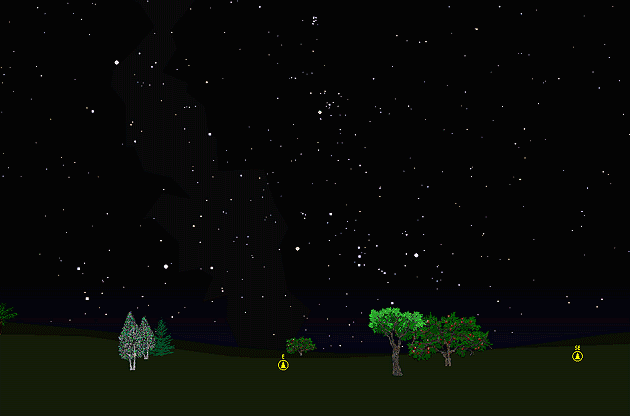The purpose of this feature is to give scout
leaders, educators and naturalists an idea of some of the natural events coming
up each month. We will try to cover a variety of natural events ranging
from sky events to calling periods of amphibians, bird and mammal watching
tips, prominent wildflowers and anything else that comes to mind. We
will also note prominent constellations appearing over the eastern horizon at
mid-evening each month for our area for those who would like to learn the
constellations. If you have suggestions for other types of natural
information you would like to see added to this calendar, let us know! Note: You can click on the hyperlinks to learn more about some of the featured items. To return to the Calendar, hit the "back" button on your browser, NOT the "back" button on the web page. Sky Events: Evening Sky: There's a lot going on in the sky this month and the total lunar eclipse on Saturday, November 8th, is certainly one of the feature attractions! Lunar eclipses occur when the moon passes through the earth's shadow. On the 8th, the full moon rises around 4:40pm CST already in the penumbra, the pale outer fringe of the earth's shadow. Usually there is little shading of the moon seen in the penumbral stages. The moon enters the umbra, or dark part of the earth's shadow, about 5:32pm CST. Totality lasts from around 7:06pm CST to 7:31pm CST. The moon clears the umbra around 9:04pm CST. The southeastern limb of the moon should be brighter at mid-eclipse.
Total lunar eclipses are quite beautiful and you need no specialized equipment to observe them. A pair of binoculars will give you a nice wide-field view of the event and show the moon's color quite well. During totality many stars previously lost in the full moon's glare become visible. You might try seeing how many of the stars in the Pleiades that you can count before the moon enters the umbra and then count again at mid-eclipse. This beautiful open cluster will only be about 14 degrees to the lower left of the eclipsed moon. You might also see if you can see the Andromeda Galaxy at mid-eclipse (see the October Natural Calendar for its location.) You can then say that you have seen this galaxy with the naked eye during a full moon, something that would normally be very difficult. Venus sets about an hour after the sun as the month begins. Look for it about 25 minutes after sunset, or around 5:15pm CST. You will want a fairly flat western horizon. By the end of the month, Mercury can be seen below Venus after sunset. The view below shows the two on Thanksgiving Day about 5:00 PM CST .
Saturn rises about 8:00pm at midmonth in central Gemini. The rings are still quite wide open and the planet is a stunning site in even a small telescope. On the evening of November 14th and again on the morning of November 25th, an 8th magnitude star passes behind the rings of Saturn as shown in the figures below. The yellow line shows the path of the star behind the ring system. The November 14th event will be more favorable. A 6" or greater aperture telescope is desirable. Stars flicker when they pass behind even very faint rings. By observing the star and watching when it flickers, you may be able to see the effects of rings much too faint to be viewed through your telescope. The rings around the planet Uranus were discovered just this way in 1977. You may also be able to see the star through the Cassini Division in the rings. There is a very faint ring, called the "f" ring, that may produce a flicker just before the star disappears behind the " A" ring. Also, watch carefully for variations in the star's light as it is visible through the semi-transparent ring "C", the "crepe" ring. Ring "C" is much fainter than is indicated by the figures. Each flicker would indicate a faint ring normally invisible to small telescopes. Dawn will interfere with the sightings on November 25th after the star is aligned with the Cassini Division.
The planet is shown as it will appear in a reflecting telescope or a refracting telescope without its star diagonal. In a Schmidt-Cassegrain telescope, or with a refractor with a star diagonal, the image will be flipped top to bottom but not left to right. The illustrations for each date show the star well before it encounters the ring system. Estimated Timings for November 14th: Disappearance behind ring "A": 11:26pm CST Appearance in Cassini Division: 11:53pm CST Appearance through ring "C": 12:08am CST (November 15th) Disappearance behind Saturn's disk: 1:03am CST (November 15th) Reappearance from behind Saturn's disk 4:31am CST (November 15th) Enter ring "C": 4:45am CST (November 15th) Disappearance behind ring "B": 5:10 CST (November 15th) Appearance in Cassini Division: 5:50am CST (November 15) Timings for the November 25th event can be found in the November issue of Astronomy magazine. Morning Sky: Jupiter rises about 1:00am at midmonth. On the morning of November 18th you may want to get up early and check the eastern sky. The Leonid meteor shower peaks on this date. Observe from around 1:00am to dawn. Although a waning crescent moon will be nearby, you may still see a nice display. Although this is not supposed to be a big year for the Leonids, the predictions are sometimes wrong. All times noted in the Sky Events are for Franklin, Tennessee and are Central Standard Time. These times should be pretty close anywhere in the mid-state area. Constellations: The views below show the sky looking east at 9:00pm CST on November 15th. The first view shows the sky with the constellations outlined and names depicted. Star and planet names are in yellow. Constellation names are in green. The second view shows the same scene without labels. Auriga, the Charioteer, with its bright star Capella, and Taurus, the Bull, with its bright star Aldebaran, are well up into the eastern sky. Look for the Pleiades, a beautiful open star cluster, above Aldebaran. Look for the bright stars Castor and Pollux as the constellation Gemini, The Twins, clears the horizon. Saturn is nestled between the twins. Due east, mighty Orion clears the horizon with its bright stars Betelgeuse and Rigel. Note the difference in color between the two stars. Betelgeuse is a red giant and looks orange. Rigel is very hot supergiant and looks bluish. Looking at the center of the three "sword" stars with binoculars, you can see M42, the Orion Nebula. Just poking its head above the horizon is Lepus, The Hare.
On Learning the Constellations: We advise learning a few constellations each month, and then following them through the seasons. Once you associate a particular constellation coming over the eastern horizon at a certain time of year, you may start thinking about it like an old friend, looking forward to its arrival each season. The stars in the evening scene above, for instance, will always be in the same place relative to the horizon at the same time and date each November. Of course, the planets do move slowly through the constellations, but with practice you will learn to identify them from their appearance. In particular, learn the brightest stars for they will guide you to the fainter stars. Once you can locate the more prominent constellations, you can "branch out" to other constellations around them. It may take you a little while to get a sense of scale, to translate what you see on the computer screen or what you see on the page of a book to what you see in the sky. Look for patterns, like the stars that make up Orion. The earth's rotation causes the constellations to
appear to move across the sky just as the sun and the moon appear to do.
If you go outside earlier than the time shown on the charts, the constellations
will be lower to the eastern horizon. If you observe later, they will
have climbed higher. As each season progresses, the earth's motion around the sun causes the constellations to appear a little farther towards the west each night for any given time of night. If you want to see where the constellations in the above figures will be on December 15th at 9:00pm CST, you can stay up till 11:00pm CST on November 15th and get a preview. The westward motion of the constellations is equivalent to two hours per month.
A good book to learn the constellations is H. A. Rey's
classic, The Stars, A New Way to See Them. Rey's depictions of the
constellations and witty commentary are terrific. A good general reference book on astronomy is the Peterson
Field Guide, A Field Guide to the Stars and Planets, by Pasachoff.
The book retails for around $14.00. A good beginners software program for learning the night sky
is the Starry Night Beginner program. Visit the Starry Night web site at
www.starrynight.com The program retails for around $30.00 and
contains a wealth of information. Amphibians: The We think of November as the quietest time of year for Tennessee frogs and toads. However, some song can still occasionally be heard. Listen for Spring Peepers, Upland Chorus Frogs and Southern Leopard Frogs. Checking around ponds at night with a flashlight held next to your temple will many times show the eye shine of Southern Leopard Frogs, Green Frogs and Bullfrogs. As in October, you can locate many of the frogs and toads that have been calling more frequently earlier in the year by driving the back roads slowly on rainy nights. This is a two person job. One person watches the road for amphibians and one person looks out for other vehicles.
Birds: You probably have already put out your bird feeders, but if you haven't you'll be missing out on a lot of good looks at winter feeder birds. This is a great time of year to start learning bird identification. Watch and listen for fall arrivals like White-throated and White-crowned Sparrows, Yellow-bellied Sapsuckers, Red-breasted Nuthatches and Brown Creepers. Listen for Great Horned Owls dueting at dusk and dawn and sometimes through the night during their courtship period. Recommended: Bird Finding in Tennessee, Michael Lee Bierly. A classic guide to finding birds in Tennessee. The Sibley Guide to Birds, David Allen Sibley The Sibley Guide to Birds of Eastern North America, David Allen Sibley This new Sibley Guide covers only eastern North America, is quite compact, and is less expensive than the larger Sibley. An inexpensive guide for beginners is the Golden Guide for Birds.
Fruits: November is a great time for all types of wild fruits. This is a great time to grab a field guide and look at acorns, hickory nuts, persimmons and berries. Vines like Moonseed and Snailseed are fruiting now.
Archives (Remember to use the back button on your browser, NOT the
back button on the web page!)
Natural Calendar
September 2003
Natural Calendar
February 2003
Natural Calendar
December 2002
Natural Calendar
November 2002
Nature Notes Archives:
Nature Notes was a page we published in 2001 and 2002 containing our
observations about everything from the northern lights display of November 2001
to frog and salamander egg masses. Night scenes prepared with Starry Night Pro software All photographs Ó2003 LEAPS
|





